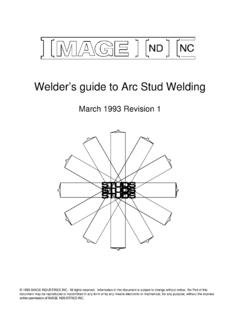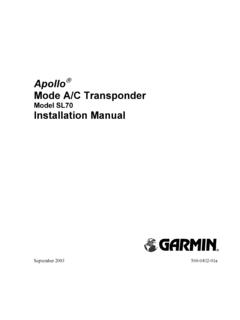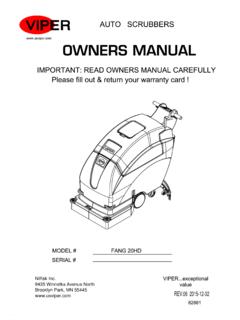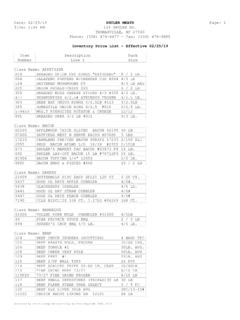Transcription of Welder’s guide to Arc Stud Welding - Image Industries
1 Welder's guide to Arc Stud Welding March 1993 Revision 1. 1993 Image Industries INC. All rights reserved. Information in this document is subject to change without notice. No Part of this document may be reproduced or transmitted in any form or by any means electronic or mechanical, for any purpose, without the express written permission of Image Industries INC. Table of Contents Sequences of a Stud Visual Inspection of Weld Studs ..4. Physical Inspection of Weld Studs ..5. Adjusting Stud Gun Adjusting Stud Gun Lift Time and Current Settings for Arc-Stud Maintenance of an Arc Stud Welding Personal Safety Power Supply Safety Precautions ..11. Definition of Stud Welding OTHER INFORMATION: Welding Handbook, Eighth Edition, Volume 2. O'Brien, , Editor, 1991. Chapter 9 Stud Welding , American Welding Society.
2 Image Industries , the Image logo and the Studs logo are trademarks of Image Industries INC. Nelson, TR1600, NS-20, NS-20HD and NS-30 are registered trademarks of TRW. 382 BALM COURT. WOODDALE, IL 60191 (708) 766-7373. 2. Sequences of a Stud Weld Chuck Stud Ferrule The gun is properly The trigger is pressed and After the arcing time is The gun is withdrawn from positioned and the main the stud lifts off the work. complete the main spring the welded stud. The gun spring is partially An arc is created and plunges the stud into the ferrule is broken away compressed. melts the stud and parent molten pool of metal and discarded. material 1.) The arc stud is loaded into the stud gun chuck. 2.) A ferrule is placed into the ferrule grip. 3.) The arc stud is positioned against the work surface to complete an electrical circuit.
3 4.) The operator initiates the weld cycle by pulling the gun trigger. 5.) The gun lifts the stud up form the work, drawing a pilot arc. 6.) The pilot arc establishes a path for the weld current which comes on after the stud is lifted. 7.) The stud remains lifted for the duration set on the controller. During this time the weld current is melting both the stud and the parent metal. 8.) When the time set on the controller has elapsed, the gun plunges the stud into the molten pool of parent material and the weld is completed. 9.) The ferrule is broken away and discarded. Two concepts which require further discussion are Plunge and Lift . What is Plunge? The amount of stud which protrudes beyond the ferrule when the stud gun is in its normal state. This represents the portion of the stud to be used in forming the weld fillet.
4 Short plunge may cause incomplete fillet formation while too much plunge may cause excessive splatter which may also leave incomplete fillets or uneven fillet formation. The amount of plunge also determines the degree of spring pressure plunging the stud. Therefore, it is logical that too much plunge will splatter the weld, while too little will result in an incomplete fillet. How Much Plunge? Typically the amount of plunge should be set at 1/8 excluding the flux ball. Vertical wall stud Welding will typically require additional plunge for complete fillet formation (3/16 ). See setting plunge in this booklet. What is Lift? The Lifting motion is essential to the stud weld process since it creates a gap which the current must bridge. This air-gap increases the electrical circuit resistance and generates the heat necessary to melt the stud and parent material for the weld.
5 If no gap exists there would be a direct short to the base material and sufficient heat would not develop. How Much Lift? The lift, once set, should not usually require changing until the gun is disassembled and cleaned. Typical lift requirements are 1/16 to 3/32 . See setting lift in this booklet. 382 BALM COURT. WOODDALE, IL 60191 (708) 766-7373. 3. Visual Inspection of Weld Studs The amount of stud metal melted and the appearance of the weld fillet can be related to the amount of power consumed in forming the weld. Visual inspection is dependent upon the interpretation of the appearance of the welded end of the stud and can be remarkably accurate if certain guidelines are followed. To assist you, the sketches and descriptions below show examples of various welds with the proper interpretation and corrective action.
6 Weld Fillet GOOD WELD HOT WELD. A good weld is characterized by a clean even fillet of A hot weld can be identified by a concave weld good height all the way (360 ) around the weld stud. fillet that is close to the work surface (washed out The fillet should be bright and shiny with a bluish color fillet). Additionally, there may be excessive weld and have a slight flow of metal into the base material material spattered beyond the area contained by from the bottom to the fillet. Another good indication of the ferrule. You may also be able to notice burn weld integrity is to check the burn-off. Place a stud through on the base material. Corrective action is next to one that has been welded, the welded one to decrease time, power or both. should be approximately 1/8 shorter. COLD WELD HANG UP.
7 A cold weld is indicated if the weld fillet is not formed A hang up occurs when the stud base is partially completely around the weld stud (360 ) or there is low melted away and the stud appears to be perched on a fillet height this may indicate a cold weld. NOTE: This small portion of its base. This is caused by a bind in may also be an indication of too little plunge. Verify the gun that prevents the stud from plunging smoothly. the plunge setting first! Another sign of a cold weld is A bind in the gun shaft will cause this, but most often a dull grayish appearance and/or stringers ( spider it is caused by the stud rubbing the ferrule. For a good legs ) coming from the weld fillet. Corrective action is weld to occur consistently, it is extremely important to increase time, power or both.
8 That the stud be exactly centered in the ferrule. The is accomplished by adjusting the gun foot. 382 BALM COURT. WOODDALE, IL 60191 (708) 766-7373. 4. Physical Inspection of Weld Studs Physical tests should be performed as part of the qualification procedure before beginning production Welding to ensure the set-up parameters are correct. This should be done at the beginning of a new shift or after changing stud diameters or materials. Physical tests are destructive and should be done only on test plates. Suggested physical tests are as follows: 1. Bend Test The stud to be tested should be bent 15 away from its weld axis and back to 0 . or until failure occurs. Bending can be done with a hammer or with the aid of a bending tool such as a tube or pipe. Failure should occur in the stud material itself or, on thin plate, a plug of base metal should be torn out.
9 2. Torque Test The stud should be torqued until a pre-specified load is attained or until the stud fails. Failure should occur in the stud material itself or, on thin plate, a plug of base metal should be torn out. 382 BALM COURT. WOODDALE, IL 60191 (708) 766-7373. 5. Adjusting Stud Welding Gun Plunge Chuck 1.) Place a chuck into the chuck Set Screw Chuck Adaptor adapter. Tap on the end lightly to Leg Screw make sure that the chuck is properly seated in the adapter. NOTE: A. Stud different chuck is required for each different stud diameter. 2.) Insert a ferrule grip into the Ferrule (Center Stud foot and tighten the set screws on in Ferrule). the foot. NOTE: A different ferrule grip is required for different size Leg ferrules. Ferrule Grip Foot 3.) Insert a stud into the chuck and a ferrule into the ferrule grip.
10 4.) Loosen the screws holding the FOOT and adjust the foot so the stud is centered in the ferrule. THIS IS IMPORTANT so there is no binding between the ferrule and the stud. This binding could cause improper welds (hang-up). A good rule of thumb is that you should be able to work the gun mechanism with the ferrule in place without knocking the ferrule out of the ferrule grip. 5.) Loosen the leg set screws (one on Adjust Legs so 1/8" to 3/16". each side of the gun). of stud is showing past ferrule 6.) Adjust the legs so that the stud Chuck extends 1/8" to 3/16" beyond the end of the ferrule. 7.) After you have properly positioned the legs, tighten the leg set screws on both sides of the gun body. Ferrule Grip NOTE: You must readjust the plunge setting when ever changing stud lengths. Foot 382 BALM COURT.






